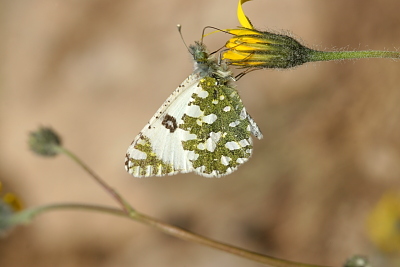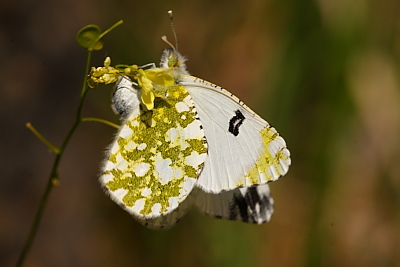







(Western) Dappled White (Euchloe crameri)
2024 photographs highlighted in yellow. Click on any photograph to go to an enlarged picture, or simply scroll down the page.
|
Visiting Var in May 2005 and in early spring every year since, my experience is that crameri is relatively common. The female has a heavier upf discoidal spot. The second brood unh is a yellower green, as shown in 0618, but the date is one week earlier than 0828 (!) showing the impact of altitude on the flight season (emergence is later at altitude - 0828 was seen at 1000m).
Euchloe is a confusing group, with a relatively recent subdivision into Eastern (ausonia) and Western (crameri) Dappled Whites, and there is also the Alpine Mountain Dappled White (E. simplonia) and the smaller and much rarer Portuguese Dappled White (E. tagis) which is found in the south-eastern corner of France. The main difference between crameri and tagis is described on the tagis page. |
Crameri also bears a superficial resemblance to the female Orange-tip (Anthocharis cardamines) although there are significant differences in the shape of the discoidal spot and the white areas on the black apical mark.
A superb video of the life-cycle of crameri has been produced by Filming VarWild and can be viewed on YouTube here: www.youtube.com/watch?v=aiVKv9CCAwA |
| ref | sex |
observations |
alt. m |
| 11096 | M |
a male, based on the lightness of the discoidal spot and a stronger white spot in the upf apical area. |
35 |
| 32449 | M | a male, nectaring on the larval hostplant Buckler Mustard (Biscutella laevigata). | 20 |
| 36892 | F | a rather unusual female, very small and with wide elongated wings, a very large upf discoidal spot and a rather yellowish tinge to the uph. It had a rather weak flight which at first suggested that it might be tagis (with a concomitant flurry of short-lived excitement), but a view of the underside showed the characteristic kink of crameri. | 140 |
| 0828 | M |
the ground colour is a much darker green, indicating a first brood, the flight season being retarded even at moderate altitudes of 1000m. The body length strongly suggests a male. |
1000 |
| 0618 | M |
the wings are slightly open, and the apical white mark possibly suggest a male. The body length also slightly suggests a male. Oddly, even on 15 May, the yellow ground colour suggests this is a second brood, quite possible as crameri is a very early emerger in Var. |
185 |
| 29165 | M | a second brood male. | 20 |
| 5185 | F |
no doubt about this one, as it is egg-laying on Buckler Mustard, it is therefore female. |
185 |
| 40249 | LARVA | a larva, which appears to be fully grown, on Buckler Mustard. | 140 |
11096_sex?_Bouches-du-Rhône_4Jun08
0828_male_Alpes-Maritimes_21May06